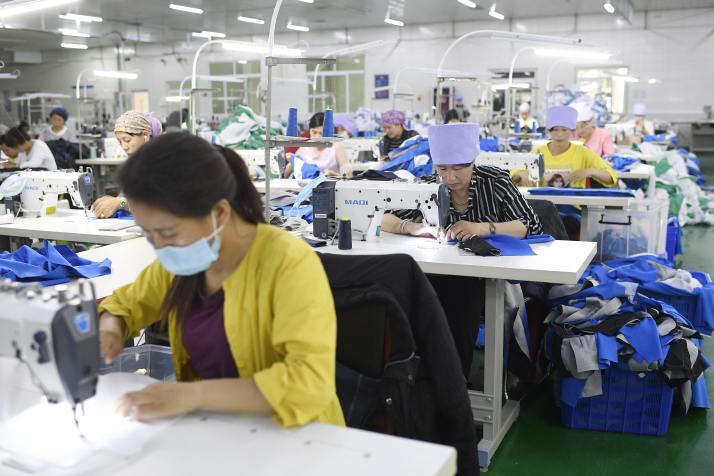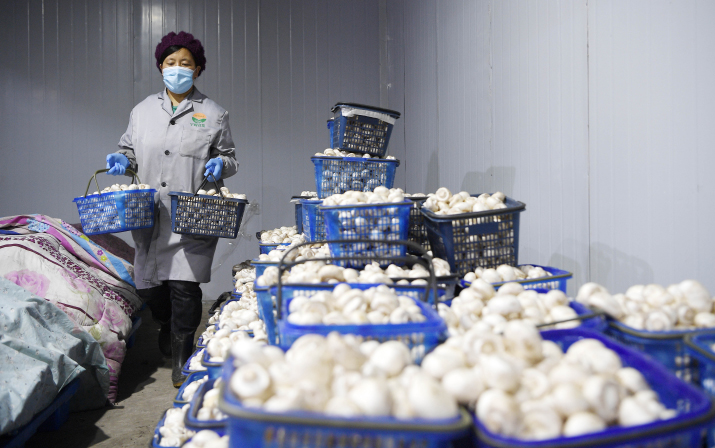|
||||||
|
||||||
| Home Nation World Business Opinion Lifestyle China Focus ChinAfrica Video Multimedia Columnists Documents Special Reports |
|
||||||
|
||||||
| Home Nation World Business Opinion Lifestyle China Focus ChinAfrica Video Multimedia Columnists Documents Special Reports |
| Nation |
| East-west cooperation program facilitates development of poverty-stricken region |
| By Lu Yan · 2020-08-10 · Source: NO.33 AUGUST 13, 2020 |
 Workers make clothes at a factory in Minning, Ningxia Hui Autonomous Region in northwest China, on July 17 (XINHUA)
Recently, Zhang Junning, 31, bought a car. This was unimaginable six years ago, when his family was still living in poverty. At that time, he had just moved from Xihaigu, an impoverished mountainous region in Ningxia Hui Autonomous Region in northwest China, to Minning Town some 300 km away. Away from the previous life of traditional farming, he was at a loss in his new surroundings in the beginning. All he could do was odd jobs like working on construction sites and he could barely make ends meet. But the pressure was soon relieved as he and his wife were hired by a vineyard. After receiving training and self-learning, they gradually gained grape-growing skills and a stable and decent income. Seeing more and more villagers like him being hired by the vineyard, Zhang came up with the idea of establishing a labor agency with the money he had earned and helping vineyards hire local villagers. His entrepreneurship enabled him to not only shake off poverty, but also build a new house and live a comfortable life. "If it weren't for the national poverty alleviation program, I might still be a poor farmer who wouldn't be able to achieve this," Zhang told China Central Television.  A mushroom planting base in Minning, Ningxia Hui Autonomous Region in northwest China, on March 18 (XINHUA)
Fruits of collaboration Since the mid-1990s, paired cooperation between China's more developed eastern regions and less developed western regions has been a major part of the strategy to alleviate poverty and bridge the previously widening wealth gap between these regions. At a conference on poverty alleviation cooperation held by the State Council in May 1996, 10 developed provinces in east China were paired with 10 underdeveloped regions in the west. Fujian, a coastal province in southeast China, was chosen to aid Ningxia. In Ningxia, there are some areas like Xihaigu that were in poverty mainly due to extreme weather. "Droughts in summer, floods in autumn and freezing cold in winter" is how locals describe the region. In 1972, the United Nations classified Xihaigu as one of the world's most uninhabitable places. Under the Fujian-Ningxia partnership, a resettlement program was proposed to move entire village communities from impoverished areas like Xihaigu to more fertile land near the Yellow River. Minning is one of the resettlement locations. As part of a poverty alleviation scheme, the development of Minning started in 1997 based on the idea of Xi Jinping, who was then deputy secretary of the Fujian Provincial Committee of the Communist Party of China and in charge of Fujian's efforts to assist Ningxia. The name Minning denotes the partnership between Fujian and Ningxia, as min refers to Fujian, while ning stands for Ningxia. Now there are over 60,000 residents in Minning. The per-capita yearly disposable income of residents in Minning rose more than 20 times to a little under 14,000 yuan ($2,013) last year, according to Zhao Chao, the town's deputy Party chief. Zhao said the town will ensure that all 22 remaining poor households shake off poverty, as 2020 is the finish line to achieve the target of eliminating absolute poverty and building a moderately prosperous society in all respects. The villagers who did not want to move to Minning were not left behind. The local government has supported the development of modern specialty industries such as fruit tree planting, which benefits both the economy and ecology. These industries offer an increasing number of jobs and other opportunities for villagers to earn a better living in Xihaigu. People power A number of government officials, teachers, medical workers, professors, experts, entrepreneurs and volunteers from Fujian have contributed to Ningxia's poverty reduction. In 1998, experts on mushroom growing and technicians from Fujian came to Minning, which at that time was a fledgling village. They offered guidance to villagers on building hundreds of mushroom greenhouses from scratch. Other commercial crops were planted following similar paths. With the development of a planting and breeding industry and an increasing number of migrants, more villages sprouted up in the area. In 2001, Minning Town was established. Now it has six administrative villages under it. The wine industry is also a pillar industry in Minning, which has suitable natural conditions. At the end of the 1990s, just a few farmers planted grapes and made wine in family workshops, not on a large scale. Later on, facilitated by the Fujian-Ningxia partnership, the industry gained a bigger scale thanks to the push of businesspeople from Fujian. Chen Deqi is one of them. He decided to set up vineyards in Minning after he visited the place in 2007. His investment has turned into nearly 5 million grape vines and over 3,000 hectares of an organic grape industrial park. His vineyard employs more than 3,000 villagers. "This is just the beginning," Chen said, adding that he plans to double the scale of his industrial park to provide more than 10,000 jobs for local residents. By the end of 2019, 5,700 Fujian companies had participated in the industrial development of Ningxia, covering more than 20 industries and contributing tens of billions of yuan in annual output. The Fujian-Ningxia partnership extends beyond economic development. In the past 24 years, more than 1,000 teachers and over 260 college students from Fujian went to middle and primary schools in Ningxia to teach students. Fujian has built 236 schools in Ningxia and assisted more than 90,000 poor students. The Fujian Provincial Government also participated in over 300 medical and health programs in Ningxia including building maternal and child care service centers and healthcare training institutions. Over 180 Fujian officials have taken temporary positions in Ningxia working to reduce poverty. Liang Jiyu, head of the Poverty Alleviation Office in Ningxia, said the people from Fujian working in Ningxia not only bring business, capital and technology, but also advanced concepts for development and rich experience. "Both Fujian and Ningxia, though thousands of miles away, share the same wish for development. The two regions will enhance mutual assistance and mutual learning, and start a new round of collaboration," said Hu Jiayue, an official of the Poverty Alleviation Office of Putian in Fujian. (Printed Edition Title: Paired for Prosperity) Copyedited by Madhusudan Chaubey Comments to luyan@bjreview.com |
About Us | Contact Us | Advertise with Us | Subscribe
|
||
| Copyright Beijing Review All rights reserved 京ICP备08005356号 京公网安备110102005860号 |